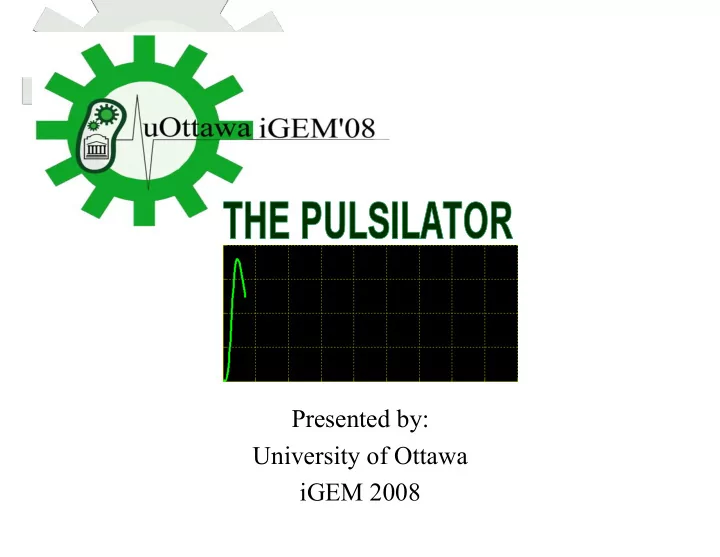

Presented by: University of Ottawa iGEM 2008
Nation’s Capital
University of Ottawa • Research intensive University • First participation in iGEM competition • Team exclusively composed and run by undergraduates
Recombinant Proteins
Expression System Bacteria Yeast Plant Mammalian Cells
I’m Limitations Tired Over-expression of recombinant protein • High metabolic burden + stress • Reduced cell growth and productivity • Selective advantage of non-producers
Our Project: The Pulsilator Synthesize recombinant proteins in short, controlled pulses , rather than continuously • Reduce average metabolic load and cellular stress • Allow cells time to recuperate • Maintain productivity of culture over long periods of time
Our Project: The Pulsilator
Chen M.-T., and Weiss R. (2005). Chassis Nature Biotech. 23(12): 1551-1555.
Chen M.-T., and Weiss R. (2005). Chassis Nature Biotech. 23(12): 1551-1555.
Chen M.-T., and Weiss R. (2005). Chassis Nature Biotech. 23(12): 1551-1555. Receiver cells Sender cells
Chen M.-T., and Weiss R. (2005). Chassis Nature Biotech. 23(12): 1551-1555. Receiver cells Incorporate: (1) tet repressor feedforward Sender cells (2) Inducer degradation – Ckx Objectives: (1) Enable pulse-generation (2) Design network reset
Pulse Generator Network Motif Incoherent Type 1 Feedforward loop IP SKN7 TetR IT1 FFL GFP
Pulse Generator Reset CKX Neg. Feedback IT1 FFL IP SKN7 TetR IT1 FFL GFP
The Design
The Design
Non-Genetic Knobs and Dials CKX E A gal/gluc IP SKN7 TetR aTc GFP
Modeling
Chen & Weiss, 2005
Chen & Weiss, 2004 Population dynamics Inducer Pulse Generator Network
Pulse Characteristics c 1.5 Concentration (a.u.) Amp. 1.3 Gain = (c-b)/b Resp. Width Time 1.1 b Offset = b-a a 0 10 20 30 Time (h)
Mixed Sender-Receiver Population
Mixed Sender-Receiver Population 0.050 k deg = 0.5 min -1 0.025 Concentration (a.u.) Pulsilator oscillations 0 somewhat fragile to 0 25 50 75 variation in Ckx 0.050 k deg = 50 min -1 parameters 0.025 0 0 25 50 75 Time (hours) K M = 40 K M = 0.15 K M = 1.5 K M = 0.015
Periodic Induction Pulsilation!!!
Periodic Induction
Periodic Induction
Periodic Induction offset offset …Low-pass filter!!!
Fine Tuning E A CKX gal/gluc IP aTc SKN7 TetR GFP
Fine Tuning Concentration (a.u.) 1.0 0.5 0 0 40 80 Time (min) No aTc Medium aTc Low aTc High aTc
Modeling Summary • Pulse generation – Pulse characteristics sensitive to transcriptional kinetic parameters • Pulsilation – Sender-receiver configuration • Highly sensitive to enzyme kinetics of IP degradation – Periodic induction configuration • Robust • Low-pass filter • Tunable
Lab Work Coarse tuning (genetic)
SSRE Induction by IP Flow cytometry – single SSRE Cell Count Fluorescence Intensity at 530nm
SSRE Induction by IP Flow cytometry – tandem SSRE 900 With IP Without IP Cell Count 10 0 10 1 10 2 10 3 Fluorescence Intensity (530nm)
SSRE Induction by IP IP dose response curve Mean Fluorescence (530nm) IP concentration (µM)
Future Directions • Maximize induction by IP • Integrate Ckx/TetR elements • Monitor IP decay by MS • Fine tuning • Adapt protocol for bioreactor production of different recombinant proteins
Acknowledgements • Mila Tepliakova • Simon St. Pierre • Dawn Fraser • Dr. Ron Weiss • Dr. Ernesto Andrianantoandro • Dr. James Collins • Dr. Thomas Schmülling • Dr. Jikta Frébortová • Dr. André Lalonde
Thank you to our sponsors
Recommend
More recommend